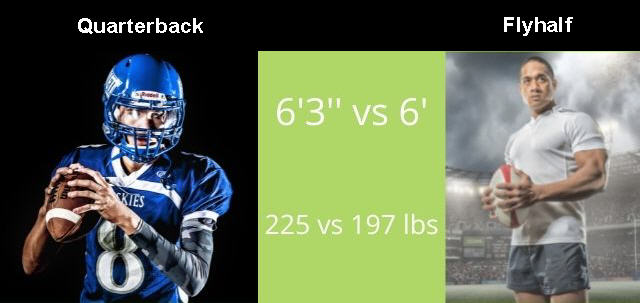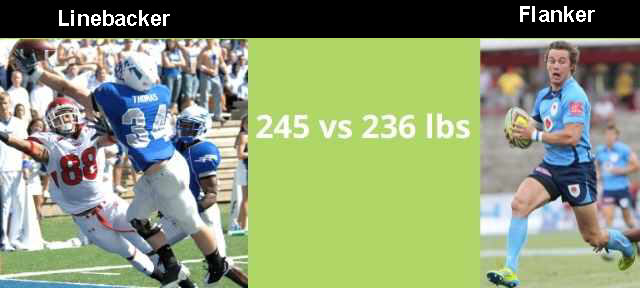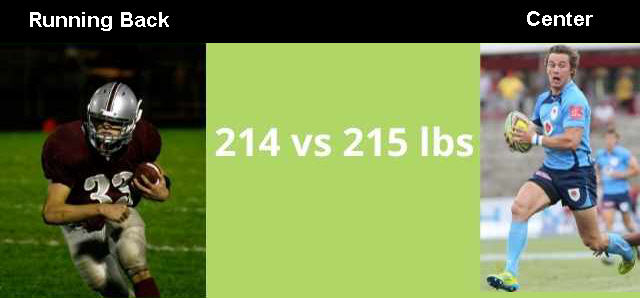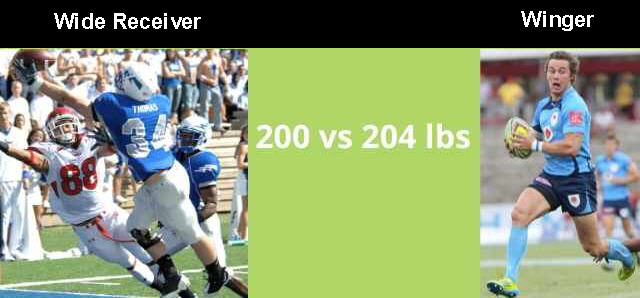Football and rugby fans have friendly arguments over which sport has the bigger athletes. You can compare individual stars in both sports, but that doesn’t really answer the question.
This article uses statistics from the NFL, college football, and the big professional rugby competitions in Europe.
I’ve picked five positions in football and compared the average heights and weights with the closest type of position in rugby. The numbers may surprise you!
Comparing Positions Between Football And Rugby
Some positions in football and rugby bear no comparison to each other. I’ve ignored prop forwards and scrum-halves in rugby because it’s hard to find the equivalent in the NFL.
However, I’ve picked five positions for direct comparisons. You may not agree with how I’ve characterized the roles! Here is how I’ve lined them up:
- Quarterback <-> Flyhalf
- Running Back <-> Center
- Wide Receiver <-> Winger
- Linebacker <-> Flanker
- Offensive Line <-> Lock *
I’ve put detailed explanations in the individual sections as to why I consider the roles to be reasonably similar.
The one exception is the final comparison of offensive linemen to rugby locks. I think the roles are very different, but I do have a reason for comparing them against each other. Read about it in the later section, and make up your own mind!
Average Sizes Of Football Versus Rugby Players By Position
Americans are used to measuring height in feet and inches, and weight in pounds. While Europeans use the metric system.
So, I’ve put together two comparison tables – one for American readers, and one for the Europeans.
American measures
Here are the comparisons of average statistics in the NFL versus professional rugby in Europe.
| NFL | Ft/In | Lbs | Rugby | Ft/In | lbs | Bigger? |
| Quarterback | 6’3” | 225 | Flyhalf | 6′ | 197 | Football |
| Running Back | 5’11” | 214 | Center | 6’1” | 215 | Rugby |
| Wide Receiver | 6’0” | 200 | Winger | 6’0” | 204 | Equal |
| Linebacker | 6’2” | 245 | Flanker | 6’3” | 236 | Football |
| Offensive Line | 6’5” | 314 | Lock | 6’6” | 257 | Football |
Here are similar comparisons but using college football.
| College | Ft/In | Lbs | Rugby | Ft/In | lbs | Bigger? |
| Quarterback | 6’2” | 207 | Flyhalf | 6′ | 197 | Football |
| Running Back | 5’10” | 202 | Center | 6’1” | 215 | Rugby |
| Wide Receiver | 6’0” | 190 | Winger | 6’0” | 204 | Rugby |
| Linebacker | 6’1” | 223 | Flanker | 6’3” | 236 | Rugby |
| Offensive Line | 6’4” | 297 | Lock | 6’6” | 257 | Football |
European measures
Here are the same comparisons using the metric system.
| NFL | Meters | Kgs | Rugby | Meters | kgs | Bigger? |
| Quarterback | 1.92 | 102.04 | Flyhalf | 1.83 | 89.33 | Football |
| Running Back | 1.80 | 97.29 | Center | 1.85 | 97.42 | Rugby |
| Wide Receiver | 1.84 | 90.86 | Winger | 1.84 | 92.50 | Equal |
| Linebacker | 1.88 | 110.97 | Flanker | 1.91 | 107.17 | Football |
| Offensive Line | 1.95 | 142.50 | Lock | 1.99 | 116.40 | Football |
And these are the numbers using college football.
| College | Meters | Kgs | Rugby | Meters | kgs | Bigger? |
| Quarterback | 1.88 | 93.89 | Flyhalf | 1.83 | 89.33 | Football |
| Running Back | 1.78 | 91.63 | Center | 1.85 | 97.42 | Rugby |
| Wide Receiver | 1.83 | 86.18 | Winger | 1.84 | 92.50 | Rugby |
| Linebacker | 1.85 | 101.15 | Flanker | 1.91 | 107.17 | Rugby |
| Offensive Line | 1.93 | 134.72 | Lock | 1.99 | 116.40 | Football |
Summary of who is bigger
The average heights and weights show a lot of variation across the different positions. But if you want a simple answer, here it is.
NFL players are bigger than professional rugby players in most positions.
College football players are smaller than NFL players in the same position, and they tend to be slightly smaller than professional rugby players.
Sources For Heights And Weights
The rugby statistics come from RugbyPass. They published heights and weights by position in the Top 14, the English Premiership, and the PRO 14 (Ireland, Scotland, Wales, and Italy).
The college football statistics come from the NCSA website.
The NFL statistics come from an academic paper.
Average Size Of Quarterbacks Versus Rugby Fly-Halfs
Quarterbacks and fly-halves run the attack for their teams.
Quarterbacks take more on-field instructions from their coaches, but they must also make tactical decisions on the fly.
A rugby fly-half is constantly making decisions that shape the attack. We’ll leave tactical kicking out of the equation.
Fly-halves initiate attacks by either passing the ball backward to a team-mate in a better position or running forward and evading tackles.
Who is bigger?
The average NFL quarterback stands 6 foot 3 inches and weighs 225 lbs.
Rugby fly-halves are smaller. They average at 6 feet and weigh 197 lbs. That still makes them 10 lbs lighter than college quarterbacks.

Average Size Of Linebackers Versus Rugby Flankers
Linebackers in football are most often compared to flankers in rugby. This is because these are the big tackling positions in their teams.
The linebacker’s main role is to tackle the opposition ball carrier. They make the most tackles of all the football positions.
Linebackers also look to heap pressure on the quarterback by rushing from their defensive line to blitz their opponent.
Flankers in rugby also have the highest tackle rate across the fifteen players on the pitch. And there’s nothing a flanker likes better than to race to tackle the opposition flyhalf as he’s about to initiate an offensive play.
Who is bigger?
There is very little difference in average height between linebackers and flankers.
Flankers average an inch higher than NFL linebackers and two inches higher than their college equivalent.
But NFL linebackers are a solid nine lbs heavier than flankers.
Interestingly, the weight differences are reversed at college level. College linebackers are 22 lbs lighter than in the NFL, and about 13 lbs lighter than professional flankers.

Average Size Of Running Back Versus Rugby Center
Running backs in football receive the ball at close quarters from the quarterback and run down the field. The short pass is known as a handoff.
That’s the closest role to the traditional role of the inside center in rugby.
Wearing the 12 jersey, this center is the closest back to the fly half in set plays.
Often, the inside center is expected to run hard into contact and gain a few yards.
Who is bigger?
Running backs and centers are about the same weight between the NFL and professional rugby. There’s about a two-inch difference in average height, with the centers being a little taller.
College running backs are 12 lbs lighter than their NFL counterparts but are about the same height.

Average Size Of Wide Receivers Versus Rugby Wingers
Wide receivers have to run fast and jump high to catch the football. They also juke and swerve to evade the defense.
Wingers in rugby share a lot of these qualities.
They are nearly always the fastest runners on a rugby pitch.
They jump to catch balls that are kicked by the opposition or their own fly half.
And they swerve and side-step to evade tacklers on the way to the try line.
Who is bigger?
Interestingly, the average height for NFL wide receivers, college wide receivers, and rugby wingers is exactly the same. They are all about 6 feet.
There’s very little difference in weight between NFL receivers and rugby wingers. College players are about a stone lighter.
This position is where players in both professional sports are just about equal.

Average Size Of Offensive Line Versus Rugby Locks
I’ll admit that the roles of the offensive linemen and rugby locks are not very similar.
The reason I’m comparing them here is that both positions are typically the tallest in their sport.
Who is bigger?
Offensive linemen average at about 6’5’’ in the NFL. The college average is an inch shorter.
Professional locks average at 6’6, so there’s not much difference there.
But there’s a big contrast in weight. NFL offensive linemen average a whopping 57 pounds heavier than professional locks.
And even college players are 40 pounds heavier.
Check out our article that looks in more depth at the average weight of NFL linemen, and how they’ve got significantly heavier across decades.
What About Speed?
Ever wondered who would win a race between an American wide receiver and an English winger?
Check out our article on whether NFL players are faster than rugby players.